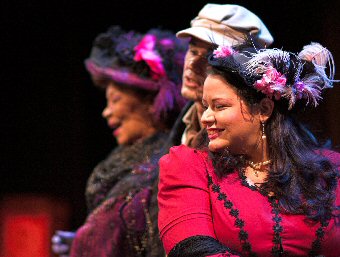Bohemians (Bohemios)
A co-production from Teatro de la Luna and Opera Theatre of Northern Virginia
Reviewed by Rosalind Lacy

(L-R): Kathy Hankins, Alvaro Rodríguez, Adriana González (Photo: Raymond Gniewek)
Even though Spain was politically unstable in 1904, composer Amadeo Vives found peace from living with freedom in his heart. He looked to the past to celebrate the carefree life of the mid-1800s by composing the music for Bohemians (Bohemios). Passionate lyrics, by Guillermo Perrin and Miguel de Palacios supported his vision of a love-filled world: The power of love “….makes the flowers in my shawl bloom,” sings the gypsy girl in Act II. Teatro de la Luna is known for leading its Spanish-speaking audiences to Latino avant garde plays. The Opera Theatre of Northern Virginia is recognized for introducing operas rarely heard. Together the two companies seem perfect partners for producing this zarzuela, a neglected orphan of Spanish musical theater that refuses to die. Beautifully sung by a splendid band of local opera singers under the artistic direction of music director John Edward Niles and staged by Mario Marcel, the ultra-romantic Bohemians soars.
But first - what exactly is a zarzuela? Literally translated, it’s a thorny bramble bush that once upon a time, surrounded the 17th century palace where this light-hearted entertainment originated and evolved into street theater with balconies around courtyards. The characters are common people, dashing gallants, shop girls, and coquettes who flirt their way through life. To cater to the diversity of regional Spain, the zarzuela composer ended up pleasing everyone by combining a potpourri of catchy folk music in a comic drama, that alternated singing, spoken dialogue and dancing. A zarzuela now stands apart as Spain’s home-grown musical comedy or operetta, that’s performed throughout Latin America. Revived in this century and brought center stage by opera stars Placido Domingo and Victoria los Angeles, zarzuelas have gained stature next to Italian operas. (The Friday post-show discussion with guest speaker Carla Hubner helps.) Here’s the way the story goes: A struggling composer, Roberto, and his sidekick poet-librettist, Victor, work in a cold garret, preparing for the debut of their opera “Luzbel (Lucifer).” As Roberto composes at his harpsichord, Cossette, the girl next door who happens to be an opera singer, annoys him by memorizing and singing his music from her open window. Ultimately the artists are united by romantic love and the love of glory in performance. Its happy ending parodies the tragic one in Puccini’s Italian opera La Boheme, which premiered in Paris (1896) a few years before.
In staging Bohemians in the almost too big Gunston Arts Center Theatre One, musical director John Edwards Niles has borrowed arias from other zarzuelas for enrichment and added a children’s ensemble to enlarge crowd scenes, both established traditions in zarzuela troupes. With panache, Niles leads a nine-piece orchestra and a cast of nine operatic voices. Three things stand out: The opera-quality voices, the way the cast takes delight in performing the arias, and the musicianship of the instrumentalists.
Tenor Alvaro Rodriguez, as the composer Roberto, endowed with a vibrant voice, shows great promise. (He’s already sung Rodolfo in La Boheme.) Equally promising is another young tenor, Pablo Henrich, who shines as the poet, Victor, left outside in the cold in the tricky, everyman-for-himself music world. Henrich has performed leading roles in zarzuelas and operas with the National Theatre in Bolivia. Soprano Lisa Archibeque as the aspiring opera star, Cossette, has the voice of an angel. She sings with a lush, heart-warming voice that conforms to the Italian bel canto style (silky-smooth, beautiful singing.) In Act II, soprano Rayanne Gonzales as Pelagia, Cossette’s caretaker, takes the spotlight in front of the red curtain as the gypsy girl to deliver one of the added bravura pieces: “I come from Spain; I am a Spaniard.” It’s a playful aria, filled with self-mockery. Concealing coy glances behind her fan, Gonzales sings with a naughty spirit: “I’m dying because of a pair of dark eyes./Eyes have stripped me to the soul—the eyes of my gypsy boy.” Brava to this singer who already has won a Zarzuela Semi-Finalist award in Placido Domingo’s OPERALIA World Opera Contest.
Another notable mention must go to the mood-enhancing, small-scale instrumental ensemble—consisting of two violins, a viola, cello, bass, two woodwinds, a piano and a French horn. So much atmosphere from so few—sometimes mocking, sometimes throbbing, sometimes echoing La Boheme. Fluttery pizzicato from the strings and a playful mood from the clarinet and horn in the famous Intermezzo seem to recap the entire play.
The staging of Bohemians (Bohemios) at the Gunston Arts Center in Arlington is a first for the area and hopefully not the last collaboration for a zarzuela. (Running time: approximately one hour and a half.) Bohemians (Bohemios), a Spanish zarzuela (Spanish operetta) by Amadeo Vives, performed in Spanish with English supertitles projected, continues next weekend at the Gunston Arts Center, Theatre One, 2700 S. Lang St., Arlington, VA. 22206. Fri., Sat. 8 p.m.; Sun. mat. 3 p.m. Tickets: Center $35, Students/Sr. over 60, $31.50. Side: $30; Student/Sr. $27. Post-show discussion on Friday. Free parking available. Childcare $10 provided on Sundays w 24/hour notice. Opera Theatre Northern Virginia (OTNV): 703-528-1433; [email protected]. Teatro de la Luna: 703-548-3092. [email protected].
 Modified
Modified
